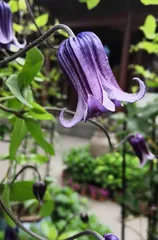Climbing flowers are a type of plant that many gardening enthusiasts love, favored for their unique growth habits and beautiful blossoms. However, for many people, the most frustrating problem when growing climbing flowers is pest infestation. Common pests like aphids and spider mites not only damage the plant's health but also cause the flowers to lose their beautiful appearance. This article will provide you with some methods and suggestions to help you choose healthy climbing flowers and care for them properly, thus avoiding pest problems.

I: Understanding Climbing Flowers
Climbing flowers are a type of plant with unique growth habits, often used for greening and decoration, such as wisteria, trumpet vine, and honeysuckle. These plants share a common characteristic: they can continuously climb during their long growth process, forming unique tree shapes. The leaves of these flowering plants often take on various shapes like heart-shaped, oval, or long and narrow.
II: Choosing the Right Varieties
To grow healthy climbing flowers, you must first choose suitable varieties. Different varieties of climbing flowers have different environmental adaptations and growth habits, and some varieties are more susceptible to pests. Therefore, when selecting climbing flowers to plant, be sure to choose varieties with pest-resistant characteristics, such as wisteria and trumpet vine.

III: Selecting the Right Soil
Climbing flowers have relatively high requirements for soil; they generally prefer moist, fertile soil. Therefore, during cultivation, it is essential to choose soil with a fine texture, strong water retention, and good aeration to meet the plant's nutritional needs.
IV: Light Requirements
Light is one of the key factors for the growth of climbing flowers. Most climbing flowers prefer sunlight, but excessive sunlight can scorch the leaves, leading to poor plant growth. Therefore, it is important to appropriately control the intensity of the light. If you have strong sunlight at home, you can apply a sunshade film or blinds to the windows to reduce the intensity.
V: Water Management
Climbing flowers have a high demand for water, but overwatering should be avoided, as it can make the soil too moist, affecting the plant's respiration and nutrient absorption. Therefore, pay attention to controlling the amount of water when watering, keeping the soil appropriately moist.

VI: Fertilizer Application
Growing climbing flowers requires the appropriate addition of fertilizer to provide the plant with nutrients. However, the method and timing of fertilizer use are also important. Generally, fertilizer should be added promptly during the plant's growth and flowering periods. When applying fertilizer, avoid excessive application, as it can have negative effects on the plant.
VII: Regular Pruning
Climbing flowers are fast-growing plants. If not managed, they can overgrow, leading to an unattractive shape and making them susceptible to pests. Therefore, during cultivation, it is necessary to prune the flowers regularly to control their growth and maintain their aesthetic appeal.
VIII: Pest and Disease Prevention
To avoid attracting pests, it is essential to prevent and control pests and diseases. The reason some climbing flowers are susceptible to pests is often due to poor growing conditions, such as unsuitable soil or insufficient light. Therefore, during cultivation, attention must be paid to the prevention and control of pests and diseases. Some simple methods include using pesticides, improving ventilation, and keeping the plants dry.
IX: Avoiding Over-Fertilization
To ensure the healthy growth of plants, many gardeners tend to over-fertilize. However, excessive fertilization can make plants overly robust, which in turn reduces their resistance to pests and diseases. Once pests or diseases appear, such plants are difficult to resist and are easily affected.
X: Avoiding Injury
During the plant's growth process, injuries often occur. For example, being blown over by the wind or chewed by animals. These injuries can cause the plant to lose its resistance and become susceptible to pest infestations. Therefore, during cultivation, it is important to protect the plants and prevent injuries from happening.
XI: Timed Watering
During the growth of climbing flowers, the water supply is very important. However, if you do not master the correct watering method, it can harm the plant's health. Generally, it is recommended to water only when the plant needs water.
XII: Choosing the Right Container
When planting climbing flowers, choosing the right container is also a very important step. A suitable container must have good air permeability and drainage to ensure the plant's respiration and nutrient absorption proceed normally.
XIII: Regular Spraying of Pesticides
In terms of preventing pests and diseases, regularly spraying pesticides is a good choice. You can choose some natural and non-toxic pesticides, such as chrysanthemum or garlic, and spray them on the plant's leaves regularly to effectively prevent pest infestations.
XIV: Using Fertilizer
When planting climbing flowers, the appropriate addition of fertilizer is beneficial. Fertilizer can help the plant absorb nutrients and promote growth and flowering. However, when using fertilizer, pay attention to the type and amount to avoid harming the plant.
XV:
Climbing flowers are a type of plant with unique growth habits. However, because their growing environment has a significant impact on the plants, attention to detail is required during cultivation. Choosing suitable varieties, selecting the right soil, controlling light, managing water, regular pruning, preventing over-fertilization, avoiding injury, and timed watering are all very important. Only with proper care can you grow climbing flowers that are healthy, beautiful, and free from pests.